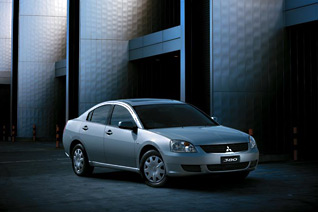In a world where timing is everything Mitsubishi probably couldn’t have chosen a worse time to introduce a six cylinder car to a market that is coming to grips with increased and unstable fuel prices.
The situation is made even worse for the company by the fact that the company in Australia wii stand or fall on the success or otherwise of this vehicle. So what is the Mitsubishi 380 really like and can it save the company?

Well if you have seen the advertising on television you have probably realised that the 380 is a rather bland looking car that’s never going to stand out in a crowd. At a time when the company really needed an eye-catching design they have opted for something that is pure vanilla.
They have also retained the front-wheel drive format which in this writer’s humble opinion is not such a bad thing but many motoring writers hold a different view and feel that Mitsubishi have missed the opportunity to move their flagship to a rear wheel drive layout just like their competitors.
The 380 comes in five different versions ranging from the base model that the company describes as “well equipped” to the 380GT that the company describes as the ultimate blend of sports and luxury. In between there are two more optioned versions of the basic sedan and a slightly cheaper version of the ultimate blend of sports and luxury.
All come equipped with a 3.8 litre V6 motor that certainly does develop some grunt. The V6 is coupled to a 5 speed manual transmission there is a 5 speed sequential transmission available as an option. The sequential box operates as an automatic but also allows manual changes up and down the range. However most drivers will set it in D and forget it.
A motor with a lot of grunt does come at a cost and the 380 is not going to be known for its great fuel consumption. Official figures suggest that 10.8 litres per 100 kilometres what you could expect from this car but that may be somewhat optimistic. Some writers report that 11.5 to 13.5 litres per 100 kilometres is going to be closer to the mark.
Those are not inspiring figures for a market place where fuel economy is becoming much more important.
Actual road handling seems to be adequate without being brilliant and at least one writer described the turning circle of the 380 as something close to the turning circle of an aircraft carrier.
Inside the car has a dashboard that could be better. It’s poorly lit and the some of the digital readouts are of little value. The trim on the cheaper versions of the 380 relies a lot on plastics and it’s obvious. At least one reviewer suggested that the standard of the fit-out inside the car was not up to the same standard as the Magna.
Visibility through the rear windscreen becomes a problem in heavy rain and the boot, while spacious, has a very small opening and getting anything as big as a pram into it could be awkward.
Standard equipment includes climate control/air conditioning, four airbags, ABS disc brakes, power windows and mirrors, cruise control, an alarm and six-speaker, single CD based sound system that is MP3 compatible and audio controls on the steering wheel.
Even though the price of the somewhat up market VRX comes in below that of its Holden and Ford competitors it doesn’t seem to be the car that is going to save Mitsubishi Australia.